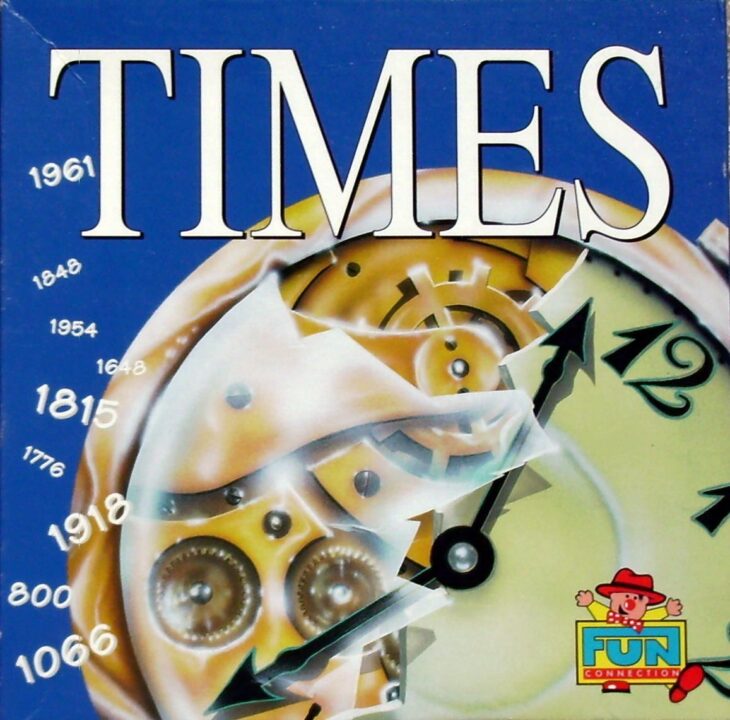Before you beg your friends to play another round of that one board game where everyone ends up mad at Aunt Linda, pull up a chair for this review of Times. I’ve bullied—I mean, convinced—my friends to play so many rounds, my kitchen table now has permanent game piece marks. Is Times worth adding to your collection, or will it gather more dust than my New Year’s resolutions? Let’s find out!
How It Plays
Setting up
First, slap that board in the middle of the table. Give each player their colored pawn and a pile of answer tokens. Shuffle those question cards! Everyone draws one (don’t peek!). Place the timer and point trackers nearby, unless you like chaos (I mean, I do—but the game works better this way).
Gameplay
On your turn, read out your question, like, “Name five countries where goats outnumber tourists.” (Yes, the questions get wild.) Everyone rushes to slap tokens and shout answers before the timer runs out. Don’t panic! But also, definitely panic. If a player stalls, heckle them—it’s in the spirit. Once the time is up, correct answers score you points. The best thing: knowing useless facts finally pays off.
Winning the game
Keep going around, reading questions and racing the timer, until someone hits the finish spot on the score track. That person wins, earns bragging rights, and gets to gloat as everyone pretends they’re happy for them (spoiler: they’re not). And just like that, you’re a trivia legend—until next game night, anyway.
Want to know more? Read our extensive strategy guide for Times.
How to Play Times: A Step-by-Step Guide
If you’ve ever wanted a board game where time flies while you rack your brain, Times is it. The rules sound simple—until you play with my friends, who all think they’re Einstein. Here’s what happens: the game gives you a timeline, a bunch of event cards, and your job is to put them in the right order. Easy, right? Wrong. Apparently, my knowledge of the 1800s is worse than my cooking.
Each player starts with a hand of event cards. On your turn, you pick one and try to slide it into the timeline. You say, “The invention of the toaster totally came before sliced bread,” place the card, and everyone groans. If you’re right, good job, grab a new card. If not, your card goes back and you hang your head in shame. The first person to run out of cards wins and gets bragging rights until the next game night. My friend Mark never lets us forget he once won by knowing when bubble wrap was invented. (Seriously, Mark?)
There’s no timer, so you can debate as long as you want. This makes Times a great pick for trivia fans and people who love to argue about history. Even with the simplest of rules, the game keeps everyone on their toes—and sometimes sparks arguments that last longer than the actual game.
Now that you know how to play Times, let’s talk about what really matters: does the game reward skill or just lucky guesses? Stay tuned for a wild ride through luck and strategy!
Luck vs Strategy: The Tug of War in Times
Let’s talk about the big debate in board games: can you win because you’re clever, or does the universe just roll a lucky six for you? In Times, this question will stare you right in the face, probably while you’re desperately hoping your card turns up the right way.
From my many, many sessions (some with snacks, some with tears), here’s the honest scoop. Times teeters on the edge between luck and strategy like my cat teeters on my Jenga tower—never quite toppling, but always making me nervous. You get moments where you feel like a genius, planning turns ahead and making that slick move. But then, WHAM!—someone else flips a game-changing card, and your strategy shrivels up like last week’s lettuce.
Some folks will love this. If you enjoy a game where tension and surprise keep you on your toes, Times delivers. Sometimes, though, luck can swing a game hard, and no amount of clever thinking can save you from a bad draw. That’s why I can’t call it a perfect game for hardcore tacticians—strategy helps, but it’s not always king here. If you want pure skill, this might not scratch your itch. If you like a bit of chaos with your coffee, Times plays fair—most of the time.
Next up, I’ll spill the beans on how Times holds up when you play with two, three, or a big ol’ group. Spoiler: things get wild!
Fun with Different Player Counts in Times
Let me tell you, Times is the kind of game that really changes its flavor depending on how many folks are at your table. I’ve played with two, I’ve played with five (once even tried with a dog present, but she just kept eating the timer!). Every time, the experience is a bit different, which keeps things fresh but sometimes throws in some weird quirks.
With just two players, Times feels almost like a head-to-head duel. You can easily track what the other person is up to, and bluffing becomes a real mind game. It’s tense, and you’ll probably accuse each other of cheating by round two. I say that with love, because in my house, we have a ban on playing Times with my cousin Jeff after the infamous “Timer Incident of 2022.”
Bump the player count up to four or five, and it gets loud, unpredictable, and much more chaotic. There’s more second-guessing, more wild guesses, and honestly, more moments where you wonder if anyone remembered the rules. I actually prefer Times with four, because it feels just right: enough chaos for laughs, but you can mostly keep track of what’s happening. With five, the waiting between turns can sometimes slow things down, especially if someone is taking their sweet time overthinking every move (looking at you, Karen!). But more players means more banter, and that’s half the fun in a game like this.
How does it play solo? Not a chance—unless you like arguing with yourself and calling it board gaming (I tried; it gets weird fast). Next up, get ready for my hot takes on the component and artwork quality in Times—hint: my cat tried to steal a card, so they must be doing something right!
Eye Candy or Eye Sore? The Components and Artwork of Times
If you know me, you know I get nerdy about board game bits. I mean, if I wanted to hold cardboard that looks like a soggy sandwich, I’d raid my fridge instead of playing Times. Let’s talk about the good stuff first: the moment I opened Times, I noticed the chunky, solid feeling to the main board. No paper-thin nonsense here. Tokens are thick enough that even my clumsy friend Dave couldn’t drop and lose them under the sofa, which is saying something.
The art, oh boy, this is an area where Times doesn’t disappoint. Each card has bright, cheerful illustrations. Nothing museum-worthy, but they pop in a playful way. I caught myself smiling at some of the silly details—a tiny snail on a clock face, or a wizard with an hourglass beard. It adds to the light mood and makes the rules easier to follow. Even my colorblind cousin could tell pieces apart, so thumbs up for accessibility!
Now, not everything is golden. If you expect minis, forget about it. Times sticks to good ol’ tokens and cards. Also, if you’re the sort who sniffs new games for that famous fresh-ink smell, well, Times is more of a ‘fresh out of the budget print shop’ vibe. I also wish the box insert did a better job of holding everything in place—mine looks organized for about three seconds before every session.
So, would I recommend Times for its components and art? Yep, unless you think a game needs gold foil and resin tokens to be fun. Times is charming in its own way. Next up: how does it stack up for value?
Conclusion
Well, that wraps up my wild ride with Times. If you want a game that’s easy to learn, gets everyone thinking fast, and works with any size group, it’s a real winner. The mix of speedy thinking and laughs makes it a hit at my game nights—just don’t expect deep strategy or total fairness. Some rounds feel more like a lottery than a brain-battle, but hey, that can be part of the fun. If you love a trivia challenge and don’t mind the odd lucky break, I’d say go for it. Thanks for reading, and may your answers always land before the timer explodes!


